Taking Care of (Fish) Business: Levels of management
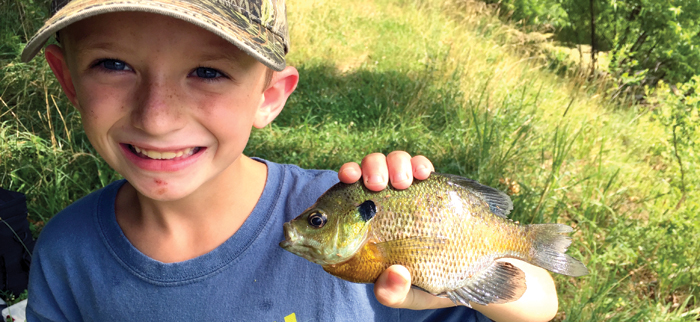
Bluegill; by David Jackson
Have you ever grumbled about the minimum size requirement, especially after you threw back that sixth undersized fish of the day? Have you ever wondered who makes these rules, why or how?
Fisheries management, like much of what we do at the Maryland Department of Natural Resources, can be considered a balancing act between two extremes of absolute prohibition (no fishing allowed!) and no protection (catch them all!) As natural resource managers, we usually want to be somewhere in the middle—a “sweet spot” where people can benefit from the resource, either commercially or recreationally, while we ensure that enough fish are protected to support a healthy ecosystem.
Location, location, location
To a degree, finding that perfect balance depends on where the fish pass their time.
Maryland is home to many marine migratory species that swim through other states’ waters and even out into federal ocean waters (beyond three miles from shore.) For example, striped bass can travel as far north as Maine and south to North Carolina every year before returning to the Old Line State in the spring! We manage more than a dozen such species, noted in the box below.
|
American eel, Atlantic croaker, Atlantic menhaden, black sea bass, bluefish, horseshoe crab, red drum, scup, shad and river herring, Spanish mackerel, spiny dogfish and coastal sharks, spotted seatrout, striped bass, summer flounder, tautog, weakfish |
Maryland is also home to many freshwater species that live in our lakes and rivers. Some, such as largemouth and smallmouth bass, may move into a neighboring state. Others, such as crappie, trout and sunfish, rarely cross state lines.
With so much variety, taking care of fish business can’t be a one-size-fits-all approach. Management becomes more complex—and more expensive—as a fish species travels farther distances and cross state and federal boundaries.
Factors that affect fish management include:
- the number of people affected or interested in the species, and the economic impact;
- the need for multi-partner cooperation to manage the species;
- the technical expertise (math and science) needed to define the regulation balance; and
- the cost to manage the species.
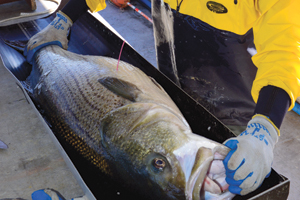
Striped bass spawning survey; by Joe Evans
Managing migratory species
Many migratory species are economically important, and because they move across state boundaries, there is a need for other states to collaborate. The federal Atlantic Coastal Fisheries Cooperative Management Act requires state agencies to pool scientific expertise and make decisions together.
To support cooperation, the federal government provides financial help to state fisheries management programs. It also pays for the Marine Recreational Information Program survey, which estimates recreational harvest for all Atlantic states. To ensure cooperation, federal law provides that the national government can shut down a state’s fishery if it is out of compliance.
Maryland’s marine migratory species are managed through a multi-state group called the Atlantic States Marine Fisheries Commission and a federal group called the Mid-Atlantic Fisheries Management Council. Maryland dedicates 100 percent of two scientists’ time and part of over a dozen scientists’ time to help with analysis to figure out the sweet spot for these species. The total cost to manage these species climbs into the millions.
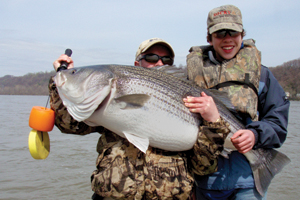 Trophy rockfish; by Chris Stephens |
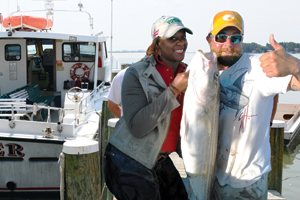 Rockfish charter trip; by Sheldon Flood |
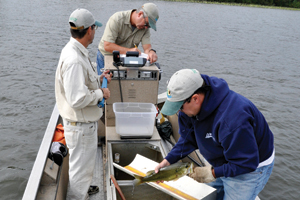
Tidal bass survey; by Karin Dodge
Managing freshwater migratory species
Freshwater species tend to be more important recreationally than they are commercially, and there are no federal requirements for states to cooperate. However, these are often sport fish, and the management sweet spot can require considerable science to determine because it is closer to absolute protection.
For example, the largemouth bass fishery of the tidal Potomac River requires several sources of scientific study because it is shared by Maryland, Virginia and the District of Columbia. Maryland dedicates time equivalent to approximately 1.5 scientists, while the two others dedicate time equivalent to approximately two scientists combined to help manage the fishery. The cost of figuring out the sweet spot has not been determined, but it is dwarfed in comparison to the cost to manage marine migratory species.
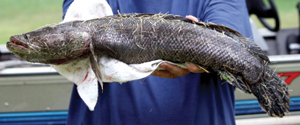 Northern snakehead; by Enoch Farson Managing troublemakers The “Big Three” invasive fish species—northern snakehead, blue catfish and flathead catfish—also cross state lines. Due to their harmful effects on our ecosystem, there is no conservation goal for these species. We place them at the extreme “no protection” end of the spectrum. |
Managing freshwater non-migratory species
Fish in this category can have fairly stable or resilient populations and require less protection, so less scientific study is currently required to manage them. However, factors such as climate change may be altering the stability of some populations, so more study may be needed in the future.
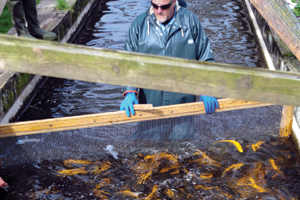
Trout stocking; by Joe Evans
Anglers enjoy catching and eating many of these species and the management goal is usually to provide a sustainable source of food. For example, Maryland ensures stability of some trout populations through stocking, which helps maintain a constant number of fish regardless of how many are caught. As a result, the regulations on size or creel limits for freshwater non-migratory species are also fairly stable, if regulations even exist.
The moral of our little story?
All fish are not alike, all fish management is not alike, and all fishing regulations are not alike. This balance of give and take, prohibition or no protection helps us protect Maryland species to ensure that current and future anglers can enjoy their sport for many years to come.
Article by Linda Barker, Ph.D—Fishing and Boating Services senior research statistician and Joseph Love, Ph.D—Fishing and Boating Services tidal bass manager.
Appears in Vol. 19, No. 4 of the Maryland Natural Resource magazine, fall 2016.


 1-888-373-7888
1-888-373-7888 233733
233733